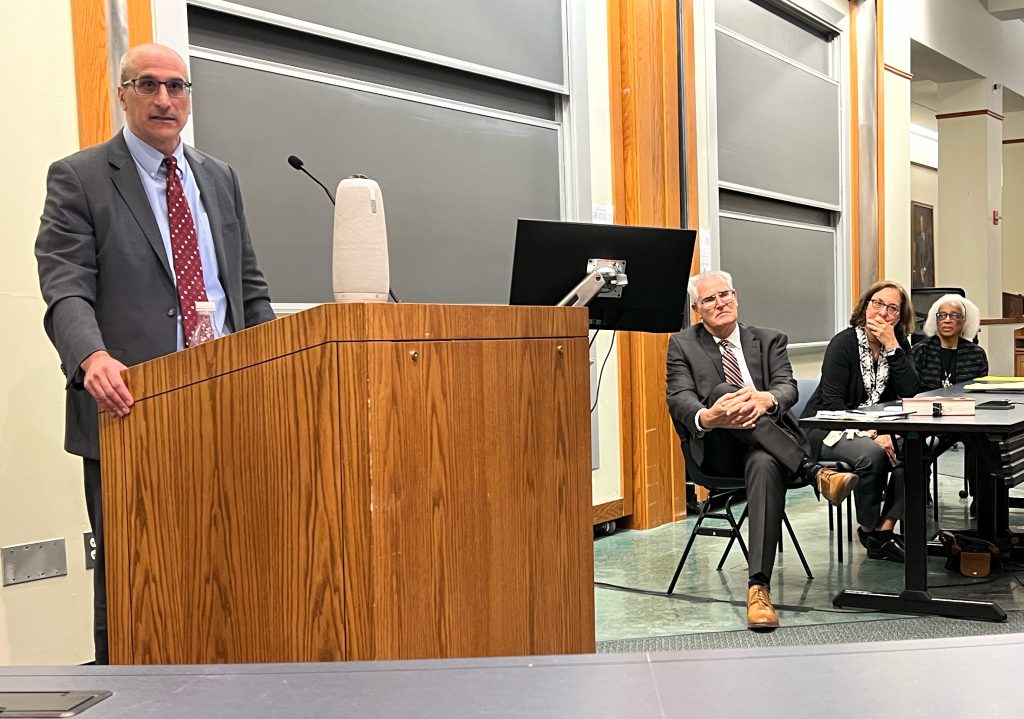Every 1L criminal law student is bound to run into the controversial felony murder rule. States that have a felony murder rule on the books (46, including Massachusetts) treat deaths that occur during the commission of another dangerous felony—even unintentional ones—as murder. What’s more, criminal liability for the death may be extended to the killer’s accomplices and co-conspirators, regardless of who pulled the literal or metaphorical trigger.
On March 16, BC Law Professor Michael Cassidy invited three colleagues to explore the current state of the felony murder rule in Massachusetts—and to debate whether it has any teeth left in the aftermath of the S.J.C.’s 2017 ruling in Commonwealth v. Brown. Justice Frank Gaziano and former Justice Geraldine Hines, both veterans of the Massachusetts Supreme Judicial Court, joined Associate Clinical Professor Sharon Beckman on the hour-long panel moderated by Cassidy.
Justice Hines kicked off the discussion by providing the relevant factual background of Brown and the history of felony murder in the Commonwealth of Massachusetts. Before Brown, felony murder operated under a theory of constructive malice: Rather than requiring the prosecution to prove malice (a necessary element to charge murder), the rule allowed for prosecutors to apply the intent to commit the original felony to the resulting killing. Thus, a death occurring during the commission of a “life felony,” such as armed robbery, would have been treated as a first-degree murder.
The post-Brown landscape looks quite different. Second-degree felony murder, the charge previously reserved for deaths that occur during “inherently dangerous” felonies, was eliminated, and prosecutors are now required to prove one of the three prongs of malice (intent to kill, intent to grievously harm, or extreme recklessness) in order to convict on murder.
Timothy Brown was convicted on two counts of first-degree felony murder after he provided the pistol and hooded sweatshirts for a botched armed robbery for which he was not present. On appeal to the SJC, Brown asked the Court to declare the rule unconstitutional, but they ultimately reduced his conviction to second-degree murder instead.
“Timothy Brown won, even though he lost his case,” Justice Hines said. “Brown may have asked us to declare felony murder unconstitutional—and, I have to say, I am waiting for somebody to force the Court to revisit its constitutionality analysis— but the SJC did reduce his conviction and ensured he would have the possibility of parole.”
Justice Gaziano wrote a concurring opinion for the Brown case, but he candidly suggested it might have had more in common with a dissent. “Moral culpability was the rationale that the Chief Justice used, finding that felony murder liability is disconnected from our idea of moral culpability. I think that’s an overly narrow view of it,” Justice Gaziano said, seeming to endorse a more retributivist view of the rule. “The human cost of conduct is always taken into account by criminal law, and I think it’s gotten short shrift in this case.”
Beckman, director of BC’s Innocence Program, added another perspective on the issue as she told the story of client Bill Casconne who was wrongfully convicted of arson and felony murder. Without the felony murder rule, she noted, he would not have received the mandatory life sentence or spent the next 35 years of his life in prison for a crime he never committed.
“The prosecution’s burden of proving the elements of the crime is beyond the reasonable doubt. What the felony murder rule does—and the accomplice liability and other constructive theories of malice—is lessen the prosecution’s burden of proof,” Beckman said. “When you lessen the burden of proof, you increase the risk that an innocent person will be wrongfully convicted.”


